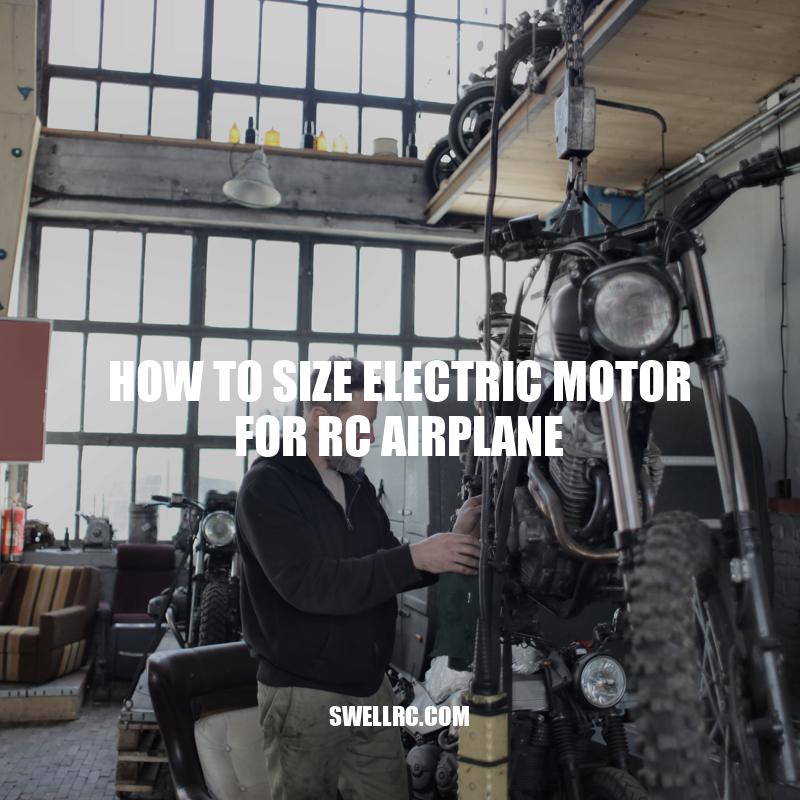How to Size Electric Motors for RC Airplanes: A Comprehensive Guide
Electric motors have revolutionized the world of remote control (RC) airplanes, providing a cleaner, quieter and more efficient alternative to gas-powered engines. When it comes to choosing the right motor for your RC airplane, size matters. The right motor can make the difference between a smooth, stable flight and a crash, which could result in damage to the aircraft or endangering the safety of people and property on the ground. It is important to understand the relationship between motor size, power output and weight to ensure that the aircraft performs as expected, while maintaining safety standards. This article will help you understand the key factors involved in sizing an electric motor for your RC airplane, including identifying the aircraft type, measuring weight and wing loading, calculating power-to-weight ratio, understanding motor ratings and propeller selection, and choosing the right battery. Armed with this knowledge, you will be able to choose the right motor size for your RC airplane and enjoy a successful and safe flight.
Determining the Aircraft Type
To choose the right motor size, it is essential to identify the type of aircraft you have. The size of the motor is dependent on the weight of the airplane and the kind of flying you plan to do. Here are some points to consider:
– Trainer: These planes are slower and easier to fly, and they typically have lower wing loading. The motor size required for such planes is relatively small.
– Sport: Sport planes are designed for speed and maneuverability. They are heavier, and the wings are loaded more heavily. As such, they require more powerful motors.
– Scale: Scale planes are designed for a realistic appearance and are generally heavier than other planes. The size of the motor required is dependent on the scale of the plane.
– 3D: These planes are specially designed for aerobatics and require powerful motors to perform well.
There are many websites that can help you determine the appropriate motor size for your aircraft type. Some of these websites provide interactive tools to help calculate the required motor size based on airplane weight and other factors. One such website that offers this service is ecalc.ch. Their tool will help you calculate the required motor size, propeller size, and battery size based on your aircraft type and other factors.
How do I identify an aircraft type?
There are several ways to identify different aircraft types. Here are some options:
- Check the airline’s website where you purchased your ticket for information on the make and model of the aircraft.
- Download an aviation app such as FlightRadar24, which provides real-time flight tracking and the aircraft type.
- Look for the registration number on the side of the plane and search for it on the Federal Aviation Administration’s (FAA) registry website.
- Consult aviation enthusiasts forums or websites, where plane spotters and aviation geeks discuss different aircraft types.
Remember, identifying an aircraft type is not only fun, but also important for avgeeks and for those with an interest in aviation.
Measuring Weight and Wing Loading
To determine the motor size, you need to know the overall weight of the aircraft. This includes the airplane’s body, battery, motor, propeller, and other electronics. Here are some points to keep in mind when measuring weight:
- Weight should be measured in ounces or grams, depending on your preference.
- Make sure to factor in the weight of the battery, motor, and other electronic components.
- Remember to subtract the weight of any unused components, such as an empty fuel tank in a gas-powered plane.
Once you know the weight of the aircraft, the next step is to calculate the wing loading. This number is the total weight of the airplane divided by its wing area. The wing loading will determine how much lift the plane can generate and how it handles in the air. Here is an example table that shows how to calculate wing loading for different airplane types:
| Aircraft Type | Total Weight (oz) | Wing Area (sq. in) | Wing Loading |
|---|---|---|---|
| Trainer | 30 | 400 | 4.7 oz/sq. ft. |
| Sport | 40 | 320 | 9.4 oz/sq. ft. |
| Scale | 60 | 500 | 10.3 oz/sq. ft. |
| 3D | 50 | 300 | 8.3 oz/sq. ft. |
Knowing the wing loading will help you determine the correct size of the motor needed to power your aircraft. An appropriate motor size will provide the necessary power to lift your airplane safely and achieve optimal performance.
How do you measure wing loading?
To measure wing loading, you need to know the total weight of an aircraft and the surface area of its wings. The formula for wing loading is:
Wing loading = Total weight of aircraft / Surface area of wings
There are a few ways to measure wing loading, including:
- Using a wing loading scale
- Using a device that measures the air pressure under the wings
- Calculating it manually using the formula above
It’s important to note that wing loading is a critical factor in aircraft performance, stability, and maneuverability. If you’re interested in learning more about aviation and aircraft design, check out websites like AIAA or products like “Introduction to Flight” by John Anderson.
Calculating Power-to-Weight Ratio
Once you have identified the aircraft type and calculated the wing loading, calculating the power-to-weight ratio is the next step in determining the required motor size. The power-to-weight ratio is the amount of power output (measured in watts) divided by the total weight of the aircraft (measured in ounces or grams).
Here are some tips when calculating the power-to-weight ratio:
– For a sport airplane, a power-to-weight ratio of 100 watts per pound is recommended.
– A scale airplane requires a slightly higher power-to-weight ratio of around 125-150 watts per pound.
– For 3D planes, a power-to-weight ratio greater than 150 watts per pound is ideal.
You can use online calculators to determine the exact motor size required based on the calculated power-to-weight ratio. Websites such as eCalc and RcGroups provide useful tools to help you calculate the power-to-weight ratio and determine the right motor size for your aircraft. It is also worth noting that certain motor manufacturers provide motor recommendations based on the aircraft type and wing loading. Checking the manufacturer’s website or product specifications can be another useful resource in selecting an appropriate motor for your RC airplane.
How do you calculate motor power requirement?
Calculating the power requirement of a motor is important to ensure that the motor is the right size for the job. Here are the steps to calculate motor power requirement:
- Determine the load torques, speeds and time.
- Calculate the mechanical power required. Mechanical power (kW) = (Load Torque (N.m) x Speed (RPM)) / 9.55
- Calculate the required motor power. Motor power (kW) = Mechanical power (kW) / Motor efficiency
- Choose a motor with a power rating greater than or equal to the required motor power.
There are online motor power calculators available that can simplify the process. If you are looking for a reliable and efficient motor supplier, check out Baldor Electric for a wide range of motors and related products.
Understanding Motor Ratings and Propeller Selection
To choose the right motor size for your RC airplane, it’s important to understand motor ratings and how they affect performance. Here are some things to consider when selecting a motor:
- KV rating: The KV rating of an electric motor is the number of revolutions per minute (RPM) it will turn per volt. Higher KV ratings generate more RPM but can also draw more current, causing the motor to heat up.
- Motor size: The size and weight of the motor also affect performance. A larger motor may generate more power, but it will also weigh more, affecting the aircraft’s total weight and balance.
- Propeller size: The size of the propeller is crucial to motor performance. Choosing the right propeller can improve efficiency and reduce overheating.
When selecting a propeller, consider the motor’s recommended propeller size, voltage and current ratings. Online propeller selection tools such as APC’s interactive propeller selection guide can provide useful information on selecting the right propeller based on motor size and aircraft type.
In addition, some motor manufacturers provide recommended propeller sizes and specifications based on their motors. Check the manufacturer’s website or product specifications to ensure you’re selecting an appropriate propeller. By choosing the right motor size and propeller, you can improve the performance and efficiency of your RC airplane.
How do I choose a propeller for my motor?
- Determine the motor’s recommended RPM range
- Know the motor’s horsepower and torque
- Consider the boat’s weight and size
- Choose the correct blade count and pitch
- Consider the material (aluminum, stainless steel, or composite)
For a more detailed guide on selecting a propeller, visit boats.com. Props Finder is also a helpful tool for finding the right propeller for your boat’s motor at propsfinder.com.
Choosing the Right Battery
Selecting the right battery for your RC airplane is crucial for motor efficiency and runtime. Here are some things to consider when selecting a battery:
- Voltage rating: The voltage rating of a battery affects the motor’s RPM and power output. Higher voltage batteries can provide more power but may also cause the motor to overheat.
- Capacity: Battery capacity is measured in milliampere-hour (mAh). A higher capacity battery can provide longer flight times but is also heavier, affecting the aircraft’s weight and balance.
- Discharge rate: The battery’s discharge rate is the amount of current it can deliver to the motor continuously. It’s important to select a battery with a discharge rate that can handle the motor’s current requirements.
Some battery manufacturers, such as Tattu and Maxamps, provide online battery selection tools to help choose the right battery for your motor and aircraft. Additionally, RC forums and online communities can provide useful information on battery selection and recommendations based on personal experiences.
It’s important to select a high-quality battery from a reputable manufacturer to ensure safety and performance. Cheap, low-quality batteries may not perform as expected and can pose a safety hazard. Always follow the manufacturer’s recommendations and safety guidelines when selecting and using batteries for your RC airplane.
What is the efficiency of an aircraft?
The efficiency of an aircraft is measured by how much fuel it consumes to transport passengers or cargo over a certain distance. Generally, the higher the efficiency, the lower the fuel consumption and carbon emissions.
Some factors that affect aircraft efficiency include:
- Aircraft weight and size
- Engine type and performance
- Air traffic control and routing
- Weather and wind conditions
To improve aircraft efficiency, airlines are using advanced technologies such as composites, lighter materials, and biofuels. Some airlines also offer carbon offset programs that allow passengers to offset their flight emissions by supporting sustainability projects.
If you want to learn more about aircraft efficiency, you can check out aviation industry websites or products such as FlightRadar24 or aviation fuel efficiency calculators.
Conclusion
Choosing the right electric motor size for your RC airplane requires careful consideration of several factors. It’s important to understand the different requirements for different aircraft types, such as trainers, sport, scale or 3D planes. Measuring the weight and calculating the power-to-weight ratio of the aircraft is also crucial for determining the right motor size. Additionally, understanding motor ratings, selecting the right propeller, and choosing the right battery are all important factors to consider when sizing your electric motor.
RC forums, online communities, and manufacturer websites are great resources for further information and advice on electric motor sizing. With the right motor size, your RC airplane can perform better and safely meet your flight expectations.
In conclusion, selecting the right electric motor and battery for your RC airplane requires time, patience, and understanding. By following the steps outlined in this guide and using the resources available, you can ensure that your RC airplane is performing optimally with regards to power and runtime, while still being safe to fly.



